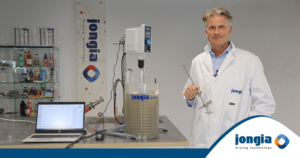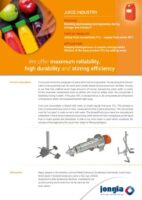Homogenizer
A homogenizer is a piece of mixing equipment that produces a consistent and uniform mixture. A homogenizer works by breaking down the mixing component materials and distributing them evenly throughout the solution. The mixing materials are either immiscible, have different sizes, or are in different phases.
Due to their efficiency in mixing materials, homogenizers play a crucial role in the food and pharmaceutical industries.
Homogenization works by pumping the sample through a narrow opening. Strong shearing forces (including cavitation and turbulence) can act on the sample in addition to high pressure to produce a high-quality product. Although numerous other mixing machines exist, the homogenizer is preferable for several reasons. It can quickly scale up and employs multiple mechanical forces (as opposed to one, as in most mixing equipment)—this quality performance results in a uniform, stable, and consistent product.
Use Of the Homogenizer in The Food Industry
Using homogenizers in the food industry provides several advantages, both to the industry and to the consumers who receive the results.
Extended Shelf Life
Among other things, the process of reducing particle sizes necessitates the use of high-pressure homogenizers. This pressure on food products frequently results in more stable chemical structures. As a result, the end product is fresher and has a longer shelf life.
Food Preservation
Food preservation is related to the benefit of extended shelf life that homogenization provides. While heat treatment is specifically designed to kill various types of harmful microorganisms and bacteria, it can also kill beneficial organisms, vitamins, and nutrients. On the other hand, high pressure is used to accomplish the same goal as its more destructive counterpart. As a result, the food is preserved and healthy.
Improved Food Quality
Food quality improves as a result of the homogenization process. Product particle size reduction results in a product with better taste, texture, appearance, and overall quality than its non-homogenized counterparts.
Applications
Homogenization In the Pharmaceutical Industry
In the pharmaceutical industry, high-pressure homogenization produces more stable products with better active material dispersion than conventional stirrers, colloid mills, and rotor-stator devices. It accomplishes this by reducing particle size and uniformity under high pressure and stress. As a result, the product is clinically effective and has a longer shelf life.
Particle Size Reduction
Given its ability to achieve uniform consistency and small particle size, homogenization is the most popular technique for particle size reduction. These properties can significantly benefit pharmaceutical products by increasing bioavailability and chemical stability, making tablet ingestion easier, and improving physical appearance.
Mechanical Homogenizers
These homogenizers break the premix components using mechanical work as the primary energy source. They work in the same way as a high-shear mixer. The material fluid or feed can be introduced at atmospheric, low, or medium pressure, which is significantly lower than the pressure of a high-pressure homogenizer.
Instead of a valve, rotating parts such as cones, blades, and paddles are used. To create the desired conditions for homogenization, the rotors are mated with a suitable stator. The mechanical tearing caused by the active components drives the homogenization process. Nonetheless, the previously mentioned physical principles required in particle disruption continue to apply to mechanical homogenizers.
Homogenizer contacts

Tom Pruymboom
Sales Director
Area Worldwide

Bart Brouwer
Area Sales Manager
Area Worldwide

Sijko van der Veen
Application Engineer
Technical Specialist
Popular Mechanical Homogenizers
Rotor-Stator Homogenizers
These homogenizers are the nearest to high shear mixers in terms of construction. Their rotor-stator assembly is frequently referred to as a mixing head, probe, or generator. The assembly is dropped into a batching tank, tube, vessel, or container to homogenise the premix fluid.
Rotor-stator homogenizers work by tangentially accelerating the fluid, but it does not entirely flow with the rotor-stator due to fluid inertia. The fluid flows toward the shear gap, which is the area between the rotor tip and the rotor-stator. High shear rates are produced by the presence of high-velocity differentials and turbulent fluid flow within the shear gap.
The rotor and stator profiles, separation distance, and other characteristics such as slots and holes all contribute to particle size control.
Colloid Mill
A colloid mill is a type of homogenizer that consists of a conical rotor-stator. The rotor and stator are separated by a narrow clearance through which shear and centrifugal forces will cause the premix to flow. The premix is thrown outward towards the exit holes or slot as it is gravimetrically loaded into the rotor-stator assembly by a hopper.
The rotor’s high rotating speed (around 3,000-15,000 rpm) causes a significant amount of shearing, which breaks the premix fluid components. Furthermore, because the rotor accelerates the solvent, high fluid velocities are possible—turbulence forms when there is enough velocity.
By varying the clearance between the rotor-stator, the magnitude of shearing can be altered. However, decreasing the clearance will reduce the product’s flow rate. The resulting particle size is limited; it is not as refined as those produced by high-pressure homogenizers.
Bead Mill Homogenizers
Bead Mills (also known as ball mills) are homogenizers that use beads to mechanically grind and break large particles scattered in the premix fluid. The beads mills are grinding media that use high impact and shearing forces to reduce particle size.
The bead mills are inserted into the container and come into contact with the premix fluid. Internal rotating components such as blades and paddles then agitate them. Agitation can also be accomplished by spinning the container at high speed. Agitation with rotating parts is common in larger rotor-stator homogenizers that are parallel to the production stream. In laboratories, centrifugal agitation is commonly used to prepare to homogenize samples.
Blade Type Homogenizers
These homogenizers have blades as their rotor. They don’t have a shear gap formed by a stator, unlike rotor-stator homogenizers and bead mills. Only the high-speed rotation of the blade produces the shearing effect. Their operation and construction are very similar to that of a blender.
Homogenizers with blades are less efficient than those with rotors and stators. Their homogenizing power is adequate for producing a well-emulsified and dispersed mixture. The resulting particle size, however, is not as refined as that produced by the other various types of homogenizers. Abrasive media, such as beads, are used to increase their homogenizing efficiency.
Frequently Asked Questions
What is a homogenizer?
A homogenizer is a mixing device that creates a consistent mixture by breaking down materials and distributing them evenly. It handles materials that are immiscible or have different sizes and phases. This equipment is essential in industries like food and pharmaceuticals for effective mixing.
What are the benefits of using homogenizers in the food industry?
Homogenizers enhance food quality by extending shelf life through particle size reduction, ensuring stability in chemical structures. They also preserve the nutritional value of foods while killing harmful microorganisms, creating healthier, fresher products for consumers.
How does homogenization work?
Homogenization pumps samples through narrow openings, applying high pressure and strong shearing forces. This process combines cavitation and turbulence to ensure uniform mixing, resulting in a consistent, high-quality product that is preferred over other mixing methods.
What are some common types of mechanical homogenizers?
Common types include rotor-stator homogenizers, colloid mills, bead mills, and blade type homogenizers. Each type utilizes different mechanisms for mixing and particle size reduction. For example, rotor-stator devices create high shear rates while bead mills use grinding beads to reduce sizes.
Why is particle size reduction important in pharmaceuticals?
Particle size reduction via homogenization improves drug bioavailability and stability, facilitating easier tablet ingestion. This process ensures that pharmaceuticals are effective and have an extended shelf life, making them more reliable for consumers.
Homogenizer – Related articles

Fermentation & Bioreactor Mixing Process
Bioreactors and Fermenters are culture systems to produce cells or organisms. They are used in various applications, including basic research and development, and the manufacturing of biopharmaceuticals, food and food additives, chemicals, and other products. A broad range of cell types and organisms can be cultivated in bioreactors and Fermenters, including cells (like mammalian cell lines, insect cells, and stem cells), microorganisms (like bacteria, yeasts, and fungi), as well as plant cells and algae. The words “Bioreactor” and “Fermenter” are basically the same thing.

How to avoid foaming in your mixing process?
Through years of experience, Jongia Mixing Technology knows the correct application to many mixing processes. So too with mixing processes where the elimination of foaming – which can occur through the behaviour of the recipe – is of great importance.

Tutorial: starch gelatinization – from raw starch to glucose syrup
Around the world, Jongia Mixing Technology has initiated numerous mixing processes using its agitators to produce modifications from raw starch and convert them into usable products. An example of a product where raw starch is one of the constituents is

















